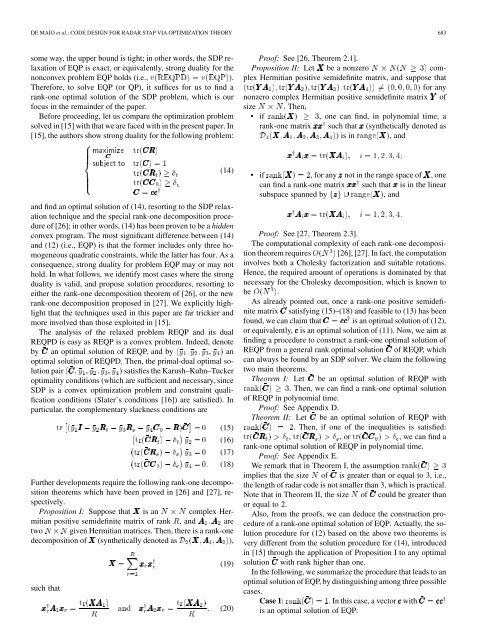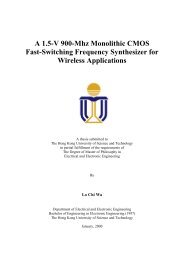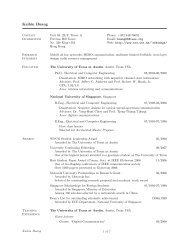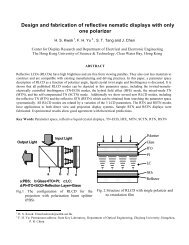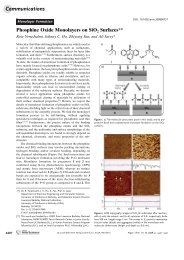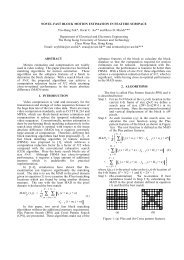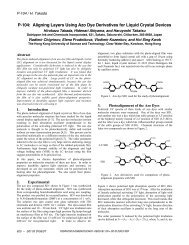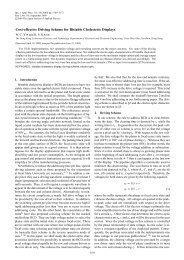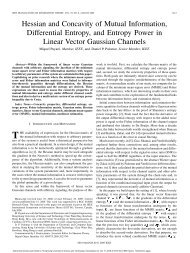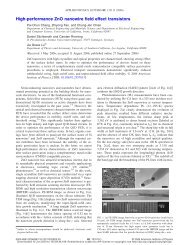Code Design for Radar STAP via Optimization Theory
Code Design for Radar STAP via Optimization Theory
Code Design for Radar STAP via Optimization Theory
Create successful ePaper yourself
Turn your PDF publications into a flip-book with our unique Google optimized e-Paper software.
DE MAIO et al.: CODE DESIGN FOR RADAR <strong>STAP</strong> VIA OPTIMIZATION THEORY 683some way, the upper bound is tight; in other words, the SDP relaxationof EQP is exact, or equivalently, strong duality <strong>for</strong> thenonconvex problem EQP holds (i.e., ).There<strong>for</strong>e, to solve EQP (or QP), it suffices <strong>for</strong> us to find arank-one optimal solution of the SDP problem, which is ourfocus in the remainder of the paper.Be<strong>for</strong>e proceeding, let us compare the optimization problemsolved in [15] with that we are faced with in the present paper. In[15], the authors show strong duality <strong>for</strong> the following problem:Proof: See [26, Theorem 2.1].Proposition II: Let be a nonzero complexHermitian positive semidefinite matrix, and suppose that<strong>for</strong> anynonzero complex Hermitian positive semidefinite matrix ofsize . Then,• if , one can find, in polynomial time, arank-one matrix such that (synthetically denoted as)isin , and(14)and find an optimal solution of (14), resorting to the SDP relaxationtechnique and the special rank-one decomposition procedureof [26]; in other words, (14) has been proven to be a hiddenconvex program. The most significant difference between (14)and (12) (i.e., EQP) is that the <strong>for</strong>mer includes only three homogeneousquadratic constraints, while the latter has four. As aconsequence, strong duality <strong>for</strong> problem EQP may or may nothold. In what follows, we identify most cases where the strongduality is valid, and propose solution procedures, resorting toeither the rank-one decomposition theorem of [26], or the newrank-one decomposition proposed in [27]. We explicitly highlightthat the techniques used in this paper are far trickier andmore involved than those exploited in [15].The analysis of the relaxed problem REQP and its dualREQPD is easy as REQP is a convex problem. Indeed, denoteby an optimal solution of REQP, and by anoptimal solution of REQPD. Then, the primal-dual optimal solutionpairsatisfies the Karush–Kuhn–Tuckeroptimality conditions (which are sufficient and necessary, sinceSDP is a convex optimization problem and constraint qualificationconditions (Slater’s conditions [16]) are satisfied). Inparticular, the complementary slackness conditions are(15)(16)(17)(18)Further developments require the following rank-one decompositiontheorems which have been proved in [26] and [27], respectively.Proposition I: Suppose that is an complex Hermitianpositive semidefinite matrix of rank , and aretwo given Hermitian matrices. Then, there is a rank-onedecomposition of (synthetically denoted as ),such that(19)(20)• if , <strong>for</strong> any not in the range space of , onecan find a rank-one matrix such that is in the linearsubspace spanned by, andProof: See [27, Theorem 2.3].The computational complexity of each rank-one decompositiontheorem requires [26], [27]. In fact, the computationinvolves both a Cholesky factorization and suitable rotations.Hence, the required amount of operations is dominated by thatnecessary <strong>for</strong> the Cholesky decomposition, which is known tobe .As already pointed out, once a rank-one positive semidefinitematrix satisfying (15)–(18) and feasible to (13) has beenfound, we can claim that is an optimal solution of (12),or equivalently, is an optimal solution of (11). Now, we aim atfinding a procedure to construct a rank-one optimal solution ofREQP from a general rank optimal solution of REQP, whichcan always be found by an SDP solver. We claim the followingtwo main theorems.Theorem I: Let be an optimal solution of REQP with. Then, we can find a rank-one optimal solutionof REQP in polynomial time.Proof: See Appendix D.Theorem II: Let be an optimal solution of REQP with. Then, if one of the inequalities is satisfied:, ,or , we can find arank-one optimal solution of REQP in polynomial time.Proof: See Appendix E.We remark that in Theorem I, the assumptionimplies that the size of is greater than or equal to 3, i.e.,the length of radar code is not smaller than 3, which is practical.Note that in Theorem II, the size of could be greater thanor equal to 2.Also, from the proofs, we can deduce the construction procedureof a rank-one optimal solution of EQP. Actually, the solutionprocedure <strong>for</strong> (12) based on the above two theorems isvery different from the solution procedure <strong>for</strong> (14), introducedin [15] through the application of Proposition I to any optimalsolution with rank higher than one.In the following, we summarize the procedure that leads to anoptimal solution of EQP, by distinguishing among three possiblecases.Case 1: . In this case, a vector withis an optimal solution of EQP.


